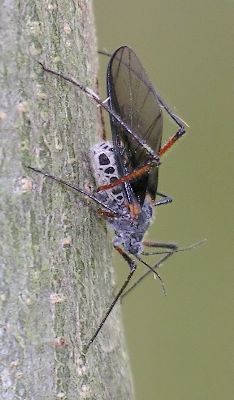by Valerie
September, 2004Giant Bark Aphid Sometimes the size of a creature influences our perception more than its anatomy. That was certainly the case when I first saw a giant bark aphid (Longistigma caryae). I had no idea what it was because my image of aphids did not include anything this large, and it wasn't until an entomologist pointed out "aphid" that I was able to identify the species. While not gigantic by some standards, the giant bark aphid, also called the North American hickory aphid, is a true giant in its family. It is the largest species in the U.S. and is fairly widespread. The body length is about ¼ inch long, but the wings and long legs give the impression of greater size.
Sometimes the size of a creature influences our perception more than its anatomy. That was certainly the case when I first saw a giant bark aphid (Longistigma caryae). I had no idea what it was because my image of aphids did not include anything this large, and it wasn't until an entomologist pointed out "aphid" that I was able to identify the species. While not gigantic by some standards, the giant bark aphid, also called the North American hickory aphid, is a true giant in its family. It is the largest species in the U.S. and is fairly widespread. The body length is about ¼ inch long, but the wings and long legs give the impression of greater size.
Aphids, sometimes called plant lice, are best known as the pests that attack our ornamental and food plants, sucking the juices out of the stems. As they feed, aphids take in far more sugars than they can use, and they secrete the excess out of their anus as honeydew. While ants love this stuff, it usually creates a sticky coating on the leaves of the plant, as well as getting on anything else nearby, such as automobiles and lawn furniture. Sooty mold usually grows on the honeydew and can block sunlight to leaves and ruin the finish on a car. Giant bark aphids feed on a variety of trees, including oak, pecan, hickory, wax myrtle, and sycamore. If an infestation is bad enough, they can kill entire limbs of a tree. In early 2002, there was a sudden population explosion of these insects in eastern Texas. Nobody knows why this happened, but I've seen such occasional increases with other insects in our area. So it doesn't come as a big surprise. Because I didn't notice these insects during that time, I don't think they affected Austin. This spring, however, I found three different individuals, prompting my research into the strange insect. All had wings and were not bloated and well fed, leading me to guess that they may have recently migrated out of more populous areas. Two of the three aphids that I found were simply resting on rocks and obviously not feeding. The third, shown in the accompanying photo, was on the trunk of one of our small pecan trees. Aphids have a curious life cycle that includes both winged (alate) and wingless (apterous) individuals, as well as females that reproduce through parthenogenesis (females only). Females can be viviparous (bearing live young) or oviparous (laying eggs). While males are less common, they do occur, especially in northern populations. Aphids are notoriously capable of fast and furious reproduction, producing as many as 50 generations in a year. While researching this species on the internet, I discovered a neat little item: the oldest fossil in Iceland happens to be an insect that closely resembles the giant bark aphid. |